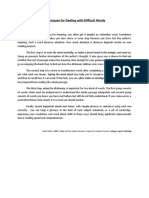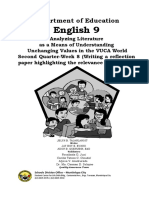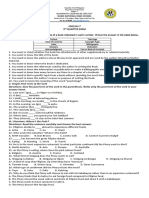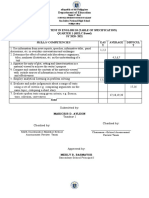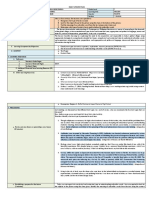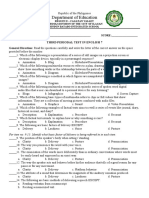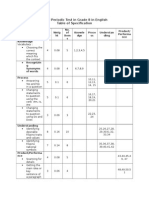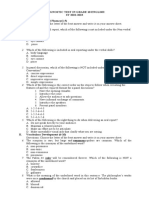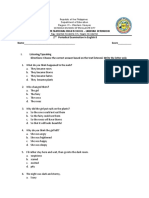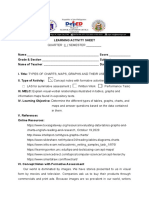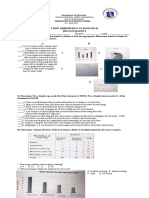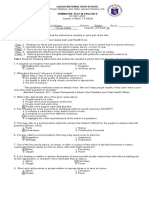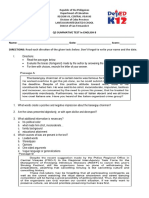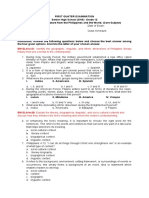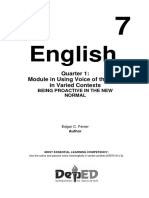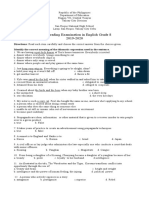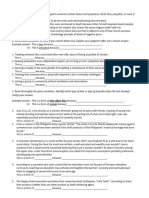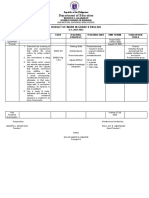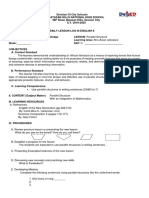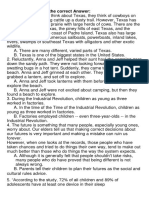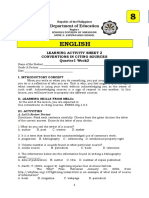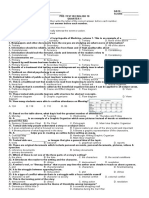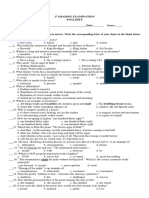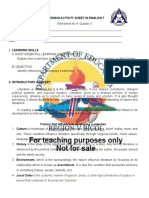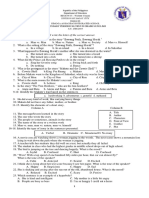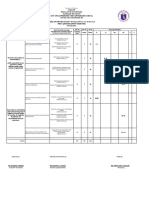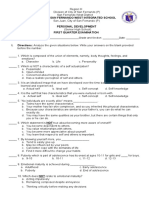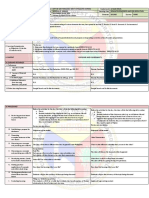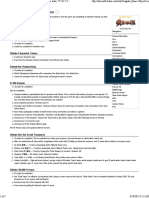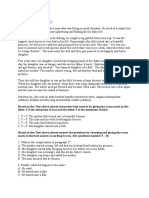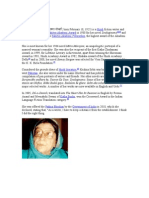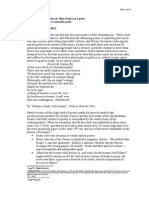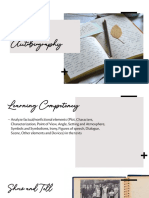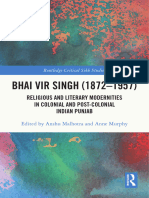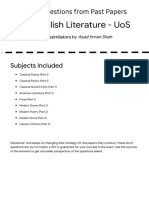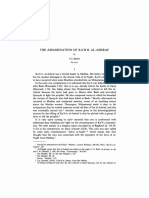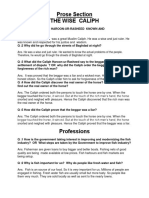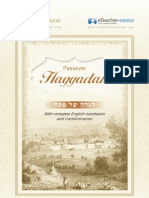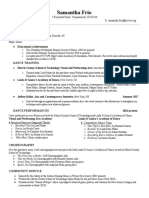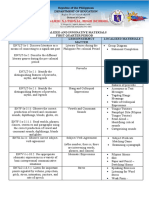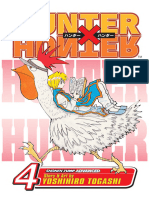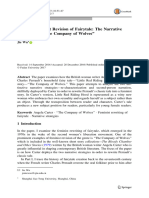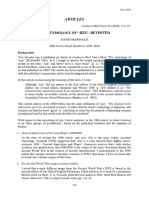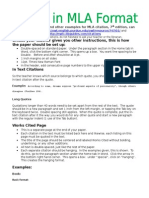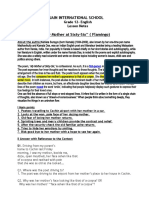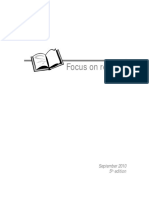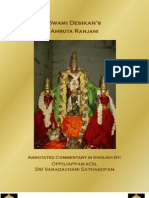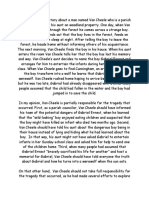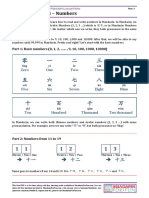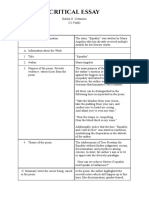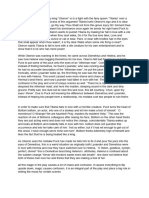0 ratings0% found this document useful (0 votes)
92 views21st Century Exam
21st Century Exam
Uploaded by
Mary Ann SabadoThis document contains a 50 question quiz about various topics in literature including genres, elements of stories, Filipino literary history, and influential Filipino writers. The questions cover terminology related to prose, poetry, drama, novels, short stories, epics, biographies, autobiographies, fiction, and non-fiction. They also address specific Filipino literary forms like bugtong, haiku, epics, folk songs, and works from different regions. Significant dates, books, and figures from the Propaganda Movement and early 20th century are mentioned. The quiz is assessing a student's knowledge of literature, particularly Filipino literature.
Copyright:
© All Rights Reserved
Available Formats
Download as DOCX, PDF, TXT or read online from Scribd
21st Century Exam
21st Century Exam
Uploaded by
Mary Ann Sabado0 ratings0% found this document useful (0 votes)
92 views2 pagesThis document contains a 50 question quiz about various topics in literature including genres, elements of stories, Filipino literary history, and influential Filipino writers. The questions cover terminology related to prose, poetry, drama, novels, short stories, epics, biographies, autobiographies, fiction, and non-fiction. They also address specific Filipino literary forms like bugtong, haiku, epics, folk songs, and works from different regions. Significant dates, books, and figures from the Propaganda Movement and early 20th century are mentioned. The quiz is assessing a student's knowledge of literature, particularly Filipino literature.
Original Description:
sa
Copyright
© © All Rights Reserved
Available Formats
DOCX, PDF, TXT or read online from Scribd
Share this document
Did you find this document useful?
Is this content inappropriate?
This document contains a 50 question quiz about various topics in literature including genres, elements of stories, Filipino literary history, and influential Filipino writers. The questions cover terminology related to prose, poetry, drama, novels, short stories, epics, biographies, autobiographies, fiction, and non-fiction. They also address specific Filipino literary forms like bugtong, haiku, epics, folk songs, and works from different regions. Significant dates, books, and figures from the Propaganda Movement and early 20th century are mentioned. The quiz is assessing a student's knowledge of literature, particularly Filipino literature.
Copyright:
© All Rights Reserved
Available Formats
Download as DOCX, PDF, TXT or read online from Scribd
Download as docx, pdf, or txt
0 ratings0% found this document useful (0 votes)
92 views2 pages21st Century Exam
21st Century Exam
Uploaded by
Mary Ann SabadoThis document contains a 50 question quiz about various topics in literature including genres, elements of stories, Filipino literary history, and influential Filipino writers. The questions cover terminology related to prose, poetry, drama, novels, short stories, epics, biographies, autobiographies, fiction, and non-fiction. They also address specific Filipino literary forms like bugtong, haiku, epics, folk songs, and works from different regions. Significant dates, books, and figures from the Propaganda Movement and early 20th century are mentioned. The quiz is assessing a student's knowledge of literature, particularly Filipino literature.
Copyright:
© All Rights Reserved
Available Formats
Download as DOCX, PDF, TXT or read online from Scribd
Download as docx, pdf, or txt
You are on page 1of 2
Name: ___________________________________ Grade & Section: _______Date: ______
I. Write the letter of the correct answer.
1. It is the body of written works produced in a particular language, country, or age, or the body of writings on a
particular subject (scientific, art, etc.)” (Merriam-Webster’s Dictionary and Thesaurus).
a. Architecture b. Literature c. Sculpture d. Culture
2. is writing that is written in normal, paragraph-style language.
a. prose b. poetry c. song d. drama
3. includes groups of lines (verses) in stanzas, which are similar to paragraphs in prose.
a. prose b. poetry c. drama d. sonnet
4. that are organized into acts and scenes with characters, dialogue, and stage directions.
a. prose b. poetry c. drama d. sonnet
5. Writing that tells about imaginary people and events; made up from the author’s imagination.
a. drama b. prose c. fiction d. non-fiction
6. Writing that is based on fact, real people, and real experiences.
a. drama b. prose c. fiction d. non-fiction
7. The TIME and PLACE of the story.
a. resolution b. setting c. setting d. characters
8. The “WHO” of the story.
a. resolution b. setting c. setting d. characters
9. The storyline or series of events that make up the story.
a. plot b. denouement c. climax d. exposition
10. A problem or struggle the character must face in the story.
a. denouement b. plot c. conflict d. climax
11. are the struggle inside the character’s mind, or within himself/herself.
a. climax b. internal conflict c. external conflict d. characterization
12. are the struggle or problem outside the characters mind.
a. climax b. internal conflict c. external conflict d. characterization
13. The most exciting part of the story – where the plot was leading.
a. climax b. internal conflict c. external conflict d. characterization
14. The narrator introduce the setting and the characters.
a. denouement b. exposition c. resolution d. climax
15. ending of the story, we learn how the conflict is solved . . . one way or another.
a. denouement b. exposition c. resolution d. climax
16. It can usually be read in one sitting, it has one main conflict that involves the characters, keeps the story moving, and
makes it interesting.
a. novel b. short story c. play d. movie
17. A long narrative poem about the adventures of a hero whose actions reflect the ideals and values of a nation or race.
a. epic b. drama c. short story d. novel
18. The writer’s account of his or her own life.
a. epic b. autobiography c. biography d. status
19. An account of a person’s life written by another person.
a. epic b. autobiography c. biography d. status
20. It is always the main character, and in most cases, he or she is the character with whom the reader identifies.
a. antagonist b. superhero c. protagonist d. first person omniscient
21. Made up of one or more measured lines with rhymes and may consist of 4 to 12 syllables. Involves reference to one
or two images that symbolize the characteristics of an unknown object that is to be guessed.
a. epic b. bugtong c. ode d. haiku
22. All of these are the purposes of bugtong, EXCEPT;
a. To entertain b. To educate c. To pray d. To preserve the culture
23. Used in witchcraft or enchantments
a. bulong b. bugtong c. salawikain d. pasyon
24. A quatrain with seven syllables each with the same rhyme at the end of each line.
a. haiku b. sonnet c. tanaga d. free verse
25. traditional poetry of the Hanunoo Mangyans of Oriental Mindoro which is normally inscribed on bamboo using a
pre-Colonial syllabic writing system called the Surat Mangyan .
a. lambada b. ambahan c. pasyon d. sonnet
26. the story of three Bicol heroes: Baltog, Handiong, Bantiong
a. Ibalon b. Biag ni Lam-Ang c. Aliguyon d. Hinilawod
27. a form of folk lyric which expresses the people’s hopes, aspirations, and lifestyles
a. poem b. folk songs c. harana d. tula
28. Kalinga rice-pounding song
a. tagay b. harana c. mambayu d. subli
29. dance-ritual song of courtship /marriage
a. tagay b. tagulaylay c. mambayu d. subli
30. songs of the dead
a. tagulaylay b. harana c. tagay d. subli
31. The first Filipino Alphabet.
a. Alibata b. Baybayin c. Katakana d. Hindu Arabic
32. This was the first book printed in the Philippines in 1593 in xylography.
a. Ang Ibong Adarna b. Ang Doctrina Cristiana c. Libro de los Cuatro Post primeras de Hombre d. Nuestra Señora del Rosario
33. This is the book about the life and sufferings of Jesus Christ
a. Pasyon b. Ang mga dalit kay Maria c. Dasalan at Tuksuhan d. Urbana at Felisa
34. this is a dramatic performance to commemorate the passion and death of Jesus Christ.
a. Pasyon b. Moro-moro c. cenakulo d. Moriones
35. A play that depicts the conflict between Muslims and Christians
a. Pasyon b. Moro-moro c. cenakulo d. Moriones
36. This is a poetic joust or a contest of skills in debate on a particular topic or issue.
a. Pasyon b. Moriones c. Cenakulo d. Balagtasan
37. The following are the objectives of the propaganda movement to seek reforms and changes, EXCEPT;
a. To get equal treatment for the Filipinos and the Spaniards under the law.
b. To make the Philippines a colony of Spain.
c. To oust the Spaniards in the Philippines
d. To restore Filipino representation in the Spanish Cortes.
38. The pen name of Rizal
a. Dimasalang b. Plaridel c. Tagailog d. Tikbalang
39. The Pen Name of Marcelo H. Del Pilar.
a. Dimasalang b. Plaridel c. Tagailog d. Tikbalang
40. The Pen Name of Antonio Luna
a. Dimasalang b. Plaridel c. Tagailog d. Tikbalang
41. Our flag was hoisted on ____________.
a. June 12, 1989 b. July 4, 1898 c. June 12, 1898 d. July 4, 1989
42. The active arousal in the field of literature started to be felt in the following newspapers, EXCEPT;
a. El Nuevo Dia b. Philippine Free Press c. El Grito del Pueblo d. El Renacimiento
43. There were also plays written then but after the first and second presentations, the Americans put a stop to this
because of the consistent theme of nationalism. Included were the following, EXCEPT;
a. Tanikalang Ginto b. Walang Sugat c. Malaya d. Moro-moro
44. These are the group of Filipino writers according to the language they are using during the American Period, EXCEPT;
a. Spanish Writers b. Filipino Writers c. English Writers d. Freedom Writers
45. The First Woman Poet in the Philippines who was good in Spanish.
a. Adelina Guerrea b. Gregoria de Jesus c. Josephine Bracken d. Marcela Agoncillo
46. These are the 3 kinds of Poets according to Julian Cruz are the following, EXCEPT;
a. Poet of the Laborer b. Poet of the Heart c. Poet of Life d. Poet of the Stage
47. Father of the Tagalog Drama.
a. Jose Javier Reyes b. Severino Reyes c. Lope K. Santos d. Amado V. Hernandez
48. Known as the Poets of the Laborer
a. Jose Javier Reyes b. Severino Reyes c. Lope K. Santos d. Amado V. Hernandez
49. Father of Ilocano Literature
a. Severino Reyes b. Lope K. Santos c. Pedro Bukaneg d. Juan Crisostomo Soto
50. This publication provided the first incentives to Filipino writers in English by offering prizes to worthwhile
contributions.
a. Philippine Free Press b. Manila Bulletin c. Philippine Star d. El Renacimiento
Parent’s Signature: ____________
Date Received: ____________
Do something that your future self will thank you for.
You might also like
- Techniques For Dealing With Difficult WordsDocument1 pageTechniques For Dealing With Difficult Wordskak_nahNo ratings yet
- 8 Final English Grade 9 Week 8 Second QuarterDocument10 pages8 Final English Grade 9 Week 8 Second QuarterMay SalomabaoNo ratings yet
- English 8 MODULE NO. 2: Communing With Nature Introduction and Focus Question (S)Document56 pagesEnglish 8 MODULE NO. 2: Communing With Nature Introduction and Focus Question (S)Pandaog Al-hadzrieNo ratings yet
- About His Person - 2014 Kingdom VersionDocument15 pagesAbout His Person - 2014 Kingdom VersionGuillaume CoatalenNo ratings yet
- Randel - The Canons in The Musicological ToolboxDocument6 pagesRandel - The Canons in The Musicological ToolboxEwaZubrzyckaNo ratings yet
- A Detailed Lesson Plan For K-12 Curriculum English Grade 7 Analogy To Show Relationships of WordsDocument6 pagesA Detailed Lesson Plan For K-12 Curriculum English Grade 7 Analogy To Show Relationships of Wordshoney jean gomezNo ratings yet
- ENGLISH 7 Exam 3rd QuarterDocument2 pagesENGLISH 7 Exam 3rd QuarterJenmarie Hermoso DullenteNo ratings yet
- First Quarterly Exam English 7Document4 pagesFirst Quarterly Exam English 7Edmon FabregasNo ratings yet
- RAT English 8Document11 pagesRAT English 8Dennis NuevoNo ratings yet
- Diagnostic Test in English 10Document3 pagesDiagnostic Test in English 10Maricris Dilao AyleonNo ratings yet
- Cot Context CluesDocument8 pagesCot Context CluesJahazelle PoloNo ratings yet
- English 7Document5 pagesEnglish 7Kenneth BielgoNo ratings yet
- Recognizing Positive and Negative Messages Conveyed in A TextDocument3 pagesRecognizing Positive and Negative Messages Conveyed in A TextMary Jane CalluengNo ratings yet
- Fourth Periodic Test in Grade 7 in English TOSDocument2 pagesFourth Periodic Test in Grade 7 in English TOSJenny Reynosa100% (1)
- Diagnostic Test Eng 10Document3 pagesDiagnostic Test Eng 10Caren Mae PunzalanNo ratings yet
- Quarter 1 Final Summative Test in English 10 (S.Y. 2021-2022)Document2 pagesQuarter 1 Final Summative Test in English 10 (S.Y. 2021-2022)Fatima FajardoNo ratings yet
- English 8 1st QuarterDocument4 pagesEnglish 8 1st QuarterMai Mai ResmaNo ratings yet
- Khs-Eng7-3rd Quarter ExaminationDocument3 pagesKhs-Eng7-3rd Quarter ExaminationAljon JayNo ratings yet
- English 8 2nd Periodical ExamDocument10 pagesEnglish 8 2nd Periodical ExamMaria Josephine V. LimNo ratings yet
- 1st Periodic Test - G7 EnglishDocument4 pages1st Periodic Test - G7 EnglishErlindaLozanoGarciaNo ratings yet
- Eng8 Las Melc1Document59 pagesEng8 Las Melc1Sheena Tejano Layba100% (1)
- ENGLISH 10 FOURTH QUARTER PERIODICAL TEST 2022 2023 For PrintingDocument3 pagesENGLISH 10 FOURTH QUARTER PERIODICAL TEST 2022 2023 For PrintingJohn Carlo LasolaNo ratings yet
- 2nd Quarter 1st Assessment Explaining Visual Verbal RelationshipDocument4 pages2nd Quarter 1st Assessment Explaining Visual Verbal RelationshipMikkie Luis SalvadorNo ratings yet
- English Final SummativeDocument3 pagesEnglish Final SummativePrecious Mae O AlcayaNo ratings yet
- Q2 English 7 Summative Test 2 Lesson 34 1Document1 pageQ2 English 7 Summative Test 2 Lesson 34 1Rhine Crbnl100% (1)
- ENGLISH 8 - Q1 - Mod2 - Coping With The New Normal PDFDocument14 pagesENGLISH 8 - Q1 - Mod2 - Coping With The New Normal PDFMarilou Cabadonga67% (3)
- Quarter 3 Summative 2020-2021Document2 pagesQuarter 3 Summative 2020-2021Dan Dennis AleraNo ratings yet
- Q3 SUMMATIVE TEST English 8Document4 pagesQ3 SUMMATIVE TEST English 8Stella Aliño GentapaNo ratings yet
- Summative Test Reading and WritingDocument3 pagesSummative Test Reading and WritingMarie Clarisse DeclaroNo ratings yet
- Test Questionnaire-RevisedDocument7 pagesTest Questionnaire-RevisedTenshi TenshiNo ratings yet
- English 7 Week 3 PDFDocument9 pagesEnglish 7 Week 3 PDFHolgado Ron Nino100% (1)
- Summative Test in Grade 7Document6 pagesSummative Test in Grade 7Josenia ConstantinoNo ratings yet
- 3RD English 8 QuestionaireDocument4 pages3RD English 8 QuestionaireChambee ChambeeNo ratings yet
- Bias and Prejudice WorksheetDocument1 pageBias and Prejudice WorksheetLISA BAIDNo ratings yet
- Long Test English7 Q3 SY 22 23Document5 pagesLong Test English7 Q3 SY 22 23Joseph HernandezNo ratings yet
- English 10Document2 pagesEnglish 10Arnel EsongNo ratings yet
- Department of Education: Budget of Work in Grade 8 EnglishDocument2 pagesDepartment of Education: Budget of Work in Grade 8 EnglishMarjorie Nuevo TorresNo ratings yet
- Sharon Parallel Structure 1Document12 pagesSharon Parallel Structure 1roeder pitaNo ratings yet
- 2nd Quarter Exam Grade 8Document5 pages2nd Quarter Exam Grade 8Marianne EspantoNo ratings yet
- English For Academic and Professional PurposesDocument3 pagesEnglish For Academic and Professional PurposesJason Yara100% (1)
- Summative Quiz in Summarizing and ParaphrasingDocument2 pagesSummative Quiz in Summarizing and ParaphrasingEden MonforteNo ratings yet
- Las Melc234 Q4 WK2 Eng7Document5 pagesLas Melc234 Q4 WK2 Eng7CRISSYL BERNADITNo ratings yet
- 3rd Quarterly Exam in English 8Document3 pages3rd Quarterly Exam in English 8Katrina Lourdes SorianoNo ratings yet
- Q2 - LE - English 7 - Lesson 1 - Week 1Document20 pagesQ2 - LE - English 7 - Lesson 1 - Week 1Orlando NavalescaNo ratings yet
- Q2 WK 7 8 - Summative Test - English8Document3 pagesQ2 WK 7 8 - Summative Test - English8Edith Buklatin VelazcoNo ratings yet
- Lea Halim Prepared LAS For English 8 Quarter 1 Week 2Document7 pagesLea Halim Prepared LAS For English 8 Quarter 1 Week 2LeaNo ratings yet
- 3rd Periodical Exam English7Document4 pages3rd Periodical Exam English7Aguilon Layto Wendy100% (3)
- English 10Document2 pagesEnglish 10Geraldine MatiasNo ratings yet
- Learning Activity Sheets (LAS) : TITLE: Determining Social, Moral and Economic Issues in TextsDocument4 pagesLearning Activity Sheets (LAS) : TITLE: Determining Social, Moral and Economic Issues in TextsJhanzel Cordero67% (3)
- Beliefs and ConvictionsDocument10 pagesBeliefs and ConvictionsABEGAIL ANASNo ratings yet
- 1 Grading Examination English-9 Name: - Date: - Score: - Multiple Choice DirectionsDocument6 pages1 Grading Examination English-9 Name: - Date: - Score: - Multiple Choice DirectionsMharn Rosales DelosSantosNo ratings yet
- Grade-7 Day 4 Intervention L12Document21 pagesGrade-7 Day 4 Intervention L12Rosemarie CatarmanNo ratings yet
- 1st Periodical Test Eng 8Document5 pages1st Periodical Test Eng 8Aira Monica PlancoNo ratings yet
- English 7: Good Thing Is Never Too Late" (English) - The Given Proverbs Falls On What Category?Document2 pagesEnglish 7: Good Thing Is Never Too Late" (English) - The Given Proverbs Falls On What Category?JollyGay Tautoan LadoresNo ratings yet
- Q3 Summative Test in English8Document6 pagesQ3 Summative Test in English8Joelle LabadanNo ratings yet
- English 7 Q3 Las L4Document14 pagesEnglish 7 Q3 Las L4Akio LukbanNo ratings yet
- Q1 Lesson 1 TYPES OF CONTEXT CLUESDocument57 pagesQ1 Lesson 1 TYPES OF CONTEXT CLUESJoel AlcantaraNo ratings yet
- 1st QUARTER - Final English 10Document33 pages1st QUARTER - Final English 10Jose A. Trinidad Jr.75% (4)
- THIRD QUARTERLY EXAMINATION 21st Cent First HalfDocument4 pagesTHIRD QUARTERLY EXAMINATION 21st Cent First HalfLea Camille Basug PacleNo ratings yet
- ENGLISH GRADE 8 2ND EXAM EditedDocument3 pagesENGLISH GRADE 8 2ND EXAM EditedSanen100% (1)
- Reading Assessment Program Guide For Grade 10: Rubric and Reading PassagesFrom EverandReading Assessment Program Guide For Grade 10: Rubric and Reading PassagesNo ratings yet
- Mam Jen 21st Century Lit q1, 2020-2021Document1 pageMam Jen 21st Century Lit q1, 2020-2021Mary Ann SabadoNo ratings yet
- PP - Tos in Phil. Politics - 2020-2021Document1 pagePP - Tos in Phil. Politics - 2020-2021Mary Ann SabadoNo ratings yet
- Budget of Work EappDocument4 pagesBudget of Work EappMary Ann Sabado100% (2)
- 21st Century ExamDocument4 pages21st Century ExamMary Ann SabadoNo ratings yet
- City of San Fernando West Integrated School: Appendix 32Document11 pagesCity of San Fernando West Integrated School: Appendix 32Mary Ann SabadoNo ratings yet
- Apr City of San Fernando West Integrated School ShsDocument6 pagesApr City of San Fernando West Integrated School ShsMary Ann SabadoNo ratings yet
- Rubik Cube Concept PaperDocument2 pagesRubik Cube Concept PaperMary Ann SabadoNo ratings yet
- 1st - BOW Personal Development 2020-2021Document1 page1st - BOW Personal Development 2020-2021Mary Ann SabadoNo ratings yet
- 1st Personal Development Exam SY 2020-2021Document4 pages1st Personal Development Exam SY 2020-2021Mary Ann Sabado100% (4)
- 2 RNW Week 5Document3 pages2 RNW Week 5Mary Ann SabadoNo ratings yet
- 1st - BOW Personal Development 2020-2021Document1 page1st - BOW Personal Development 2020-2021Mary Ann SabadoNo ratings yet
- 2 DRRR Week 5Document3 pages2 DRRR Week 5Mary Ann SabadoNo ratings yet
- Strong 3 Strong 4 Very Strong: - 23. I Feel and Act With Confidence. - 24. I Am A Mature PersonDocument5 pagesStrong 3 Strong 4 Very Strong: - 23. I Feel and Act With Confidence. - 24. I Am A Mature PersonMary Ann SabadoNo ratings yet
- Strong 3 Strong 4 Very Strong: - 23. I Feel and Act With Confidence. - 24. I Am A Mature PersonDocument5 pagesStrong 3 Strong 4 Very Strong: - 23. I Feel and Act With Confidence. - 24. I Am A Mature PersonMary Ann SabadoNo ratings yet
- ObjectivesDocument2 pagesObjectivesandi11No ratings yet
- Soal Pak AfifThe Story of Toba LakeDocument3 pagesSoal Pak AfifThe Story of Toba LakeariftyNo ratings yet
- Krishna SobtiDocument2 pagesKrishna SobtiNikhil Kakkar0% (1)
- Keats As Romantic PoetDocument14 pagesKeats As Romantic PoetTaibur Rahaman100% (2)
- CNF4 Writing-AutobiographyDocument31 pagesCNF4 Writing-AutobiographyNah acaNo ratings yet
- Bhai Vir Singh (1872-1957) - Religious and Literary - Anshu Malhotra (Editor), Anne Murphy (Editor) - Routledge Critical Sikh Studies, 1, 2023Document254 pagesBhai Vir Singh (1872-1957) - Religious and Literary - Anshu Malhotra (Editor), Anne Murphy (Editor) - Routledge Critical Sikh Studies, 1, 2023Uday SinghNo ratings yet
- TTH PresskitDocument12 pagesTTH PresskitandrinskiNo ratings yet
- Solved Short Questions From Past Papers For MA English Sargodha UniversityDocument71 pagesSolved Short Questions From Past Papers For MA English Sargodha Universityshakir100% (1)
- The Assassination of Kabb. Al-AshrafDocument7 pagesThe Assassination of Kabb. Al-AshrafEzaz UllahNo ratings yet
- Metric English Prose SectionDocument11 pagesMetric English Prose SectionAnonymous uSOuOYVNo ratings yet
- PeschacDocument53 pagesPeschacViorel SeriaNo ratings yet
- Correct Reume-2Document1 pageCorrect Reume-2api-461169040No ratings yet
- LOCALIZED AND INNOVATIVE MATERIALS (First Quarter)Document2 pagesLOCALIZED AND INNOVATIVE MATERIALS (First Quarter)Ma VicNo ratings yet
- Hunter X Hunter v04 (2005) (Digital) (LuCaZ)Document186 pagesHunter X Hunter v04 (2005) (Digital) (LuCaZ)MarseloLingisaNo ratings yet
- Rubric For Evaluation of The ParagraphDocument2 pagesRubric For Evaluation of The ParagraphMary Ann PateñoNo ratings yet
- Carter's Feminist Revision of Fairytale The Narrative Strategies of The Company of Wolves''Document15 pagesCarter's Feminist Revision of Fairytale The Narrative Strategies of The Company of Wolves''Reginald RakeNo ratings yet
- The Etymology of Jizz, Revisited, 2016Document5 pagesThe Etymology of Jizz, Revisited, 2016David McDonaldNo ratings yet
- Mla Citation HandoutDocument3 pagesMla Citation Handoutapi-265718079No ratings yet
- My Mother at 66-NotesDocument6 pagesMy Mother at 66-NotesAaryaNo ratings yet
- Master Card XII EnglishDocument45 pagesMaster Card XII EnglishVibhor KaushikNo ratings yet
- Focus On Reading PDFDocument195 pagesFocus On Reading PDFDany Toqui100% (1)
- Amrutha RanjaniDocument57 pagesAmrutha Ranjaniajiva_rts100% (1)
- IfDocument4 pagesIfVeronicksEscabillas50% (2)
- Grabiel Ernest EssayDocument2 pagesGrabiel Ernest EssayLuna HeNo ratings yet
- Mandarin For Fun Level 1 Lesson 4Document4 pagesMandarin For Fun Level 1 Lesson 4MandarinForFunNo ratings yet
- Untitled DocumentDocument2 pagesUntitled DocumentRiri CutamoraNo ratings yet
- NigelDocument1 pageNigelRameen RehmanNo ratings yet
- 07 - Chapter 2Document31 pages07 - Chapter 2sanjeevNo ratings yet

